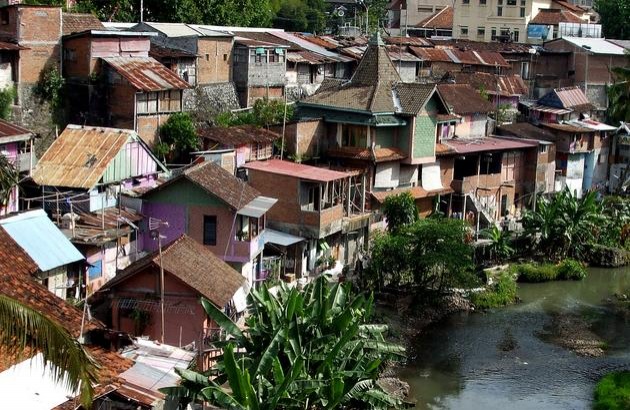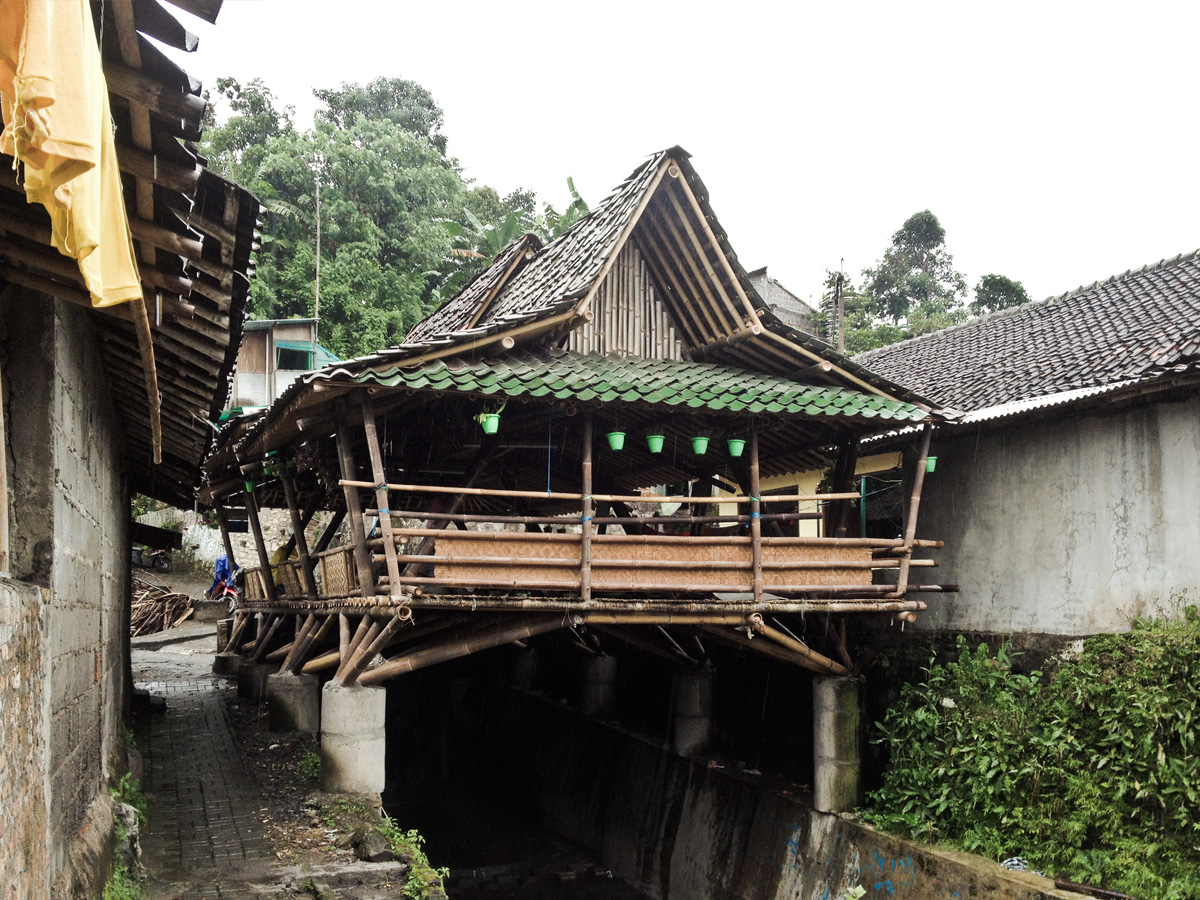#GC2022 is accepting submissions - 25d 27h 05m 44s
This article is originaly published in Inside Indonesia
As capital cities in Indonesia undergo rapid development, with vast areas converted to luxurious apartments, hotels and townhouses, the question of how to integrate informal settlements, widely known as kampungs, remains. The right to adequate housing is, after all, enshrined in the Indonesian Constitution in Article 28H, Paragraph 1.

One of the houses along Strenkali in need of renovation, and with a portion of the house removed
Architects may have a role in upholding this right. The Jakarta government in the past few years has been collaborating with the Indonesian Institute of Architects (AIA) in delivering seminars and has also run a number of architectural competitions on the design of public housing. But this is dealing strictly with the physicality of buildings. What has been emerging simultaneously is what is widely known as participatory design. In this scenario, architects no longer work just as designers, but also as grassroots facilitators. They thrive on the complexity of kampung conditions, self-consciously avoiding previous governments' methods that involve eviction and the relocation of residents to high-rise towers.
Government-led kampung upgrading has a long history in Indonesia. The most famous example is the Kampung Improvement Program (KIP) that lasted from 1969 to 1998. The aim of the nationwide program was the provision of basic infrastructure to poor neighbourhoods in cities such as Jakarta and Surabaya. It was lauded as a success story by its funder, the World Bank, and is often used as an international example of successful slum upgrading due to its visible physical improvement and its comparatively low level of investment. The program was awarded the prestigious Aga Khan Award for Architecture in 1980.
At around the same time in the mid 1980s, an alternative approach to kampung upgrading emerged, led by Romo Mangunwijaya, an architect, theologian and writer. It began as a negotiation over the plan to evict a settlement along the bank of the Code River in Yogyakarta, and morphed into a bottom-up kampung upgrading program demonstrating the resilience of the residents and their aspiration for improvement. In contrast to the KIP, the emphasis was on the empowerment of the residents. The spirit of gotong royong, or participatory mutual aid, was visible in this undertaking that also involved volunteers including students, architects and journalists.
Rather than levelling kampungs to start from scratch, the architects working on the Code River upgrading encouraged housing rehabilitation and the social aspects of spaces. They helped in the design of a community centre made of bamboo that sits on the water stream, connecting the communities in the north and the south both physically and symbolically. The program was considered a significant success and it also received the Aga Khan Award for Architecture in 1992 with the jury specifically citing its human-centred approach.

Kampung upgrading in Kali Chode, Yogyakarta. Photo by Hui Lian
Romo Mangunwijaya's activity has inspired a new generation of architects with participatory design at the core of their practice. Examples are many. In Yogjakarta, a group of young community-minded architects known as Arsitek Komunitas (Arkom) works on the other two rivers which run through Yogyakarta, the Winongo and Gajahwong. Ainun, one of the volunteers in Arkom, explains that by going from kampung to kampung, she and three other volunteers were able to convince residents to start an arisan, a community savings scheme based on a lottery system, with the aim of renovating their houses. Ainun says the scheme resulted in 140 renovations, with only one instance of the money being used for other purposes. Arkom facilitated the program, for example by teaching residents how to draft construction budgets, and by making a community map of the kampung to coordinate renovation efforts.

A community centre in Pakuncen, Kali Winongo, Yogyakarta
The program also included the construction of a community centre sitting directly over the city's drainage culvert. Designed by Arkom volunteer Andrea Fitrianto, the community centre was constructed entirely of bamboo except for the concrete foundation. During a public meeting, Gogor, the neighbourhood chief, was quick to point out that while the village men also took responsibility in constructing the centre, the women were the ones responsible for initiating and devising the program. Andrea remarked, 'The difference between this and conventional architecture is that the concept and the technology proposed here are appropriate to the available skillset in the community; appropriate to the culture, which ensures participation.' The centre was funded by the saving's group and was completed in 2013.
Participatory upgrading is also visible in Strenkali, Surabaya, where riverbank residents were threatened with eviction due to river 'normalisation' which required any structure protruding into the river to be removed to make way for an inspection road. The residents worked with a coalition of urban activist groups comprising the UPLINK Architects, Urban Poor Consortium (UPC) and Arkom to negotiate with the city government for an alternate outcome. The solution devised and agreed to by the residents, the architects and the city government was to remove the riverside part of the house, leaving the houses completely open on one side. Subsequently, an architecture design competition was held to complete the alteration. A Jakarta-based firm, SUB, was selected as the winner with a simple solution of erecting an exposed brick wall—unpainted, showing the bricks—to cover the exposed side of the house, and taught the residents how to construct it themselves and avoid eviction.
These community architects and their methods of participatory upgrading are gaining momentum. They are working with various organisations in other Indonesian cities. In Jakarta, a group by the name of Ciliwung Merdeka undertook a series of community improvement programs through facilitations. While not an architecture group, Ciliwung Merdeka has worked with architects and has facilitated workshops that deal with spatial planning. Bandung also shares a similar history of grassroots efforts in kampung upgrading. Thanks to the increase in mobility and internet penetration, many of these architects are able to connect with their peers undertaking similar work internationally. For example, affiliating with Southeast Asia-wide associations such as Community Architects Network and Asian Coalition for Housing Rights, and associating with university research programs are not uncommon. This results in a fluid, autonomous method of organisation with no centralised body. They run periodic regional meetings with the aim of sharing updates and new knowledge.
These actions are timely as both the city and the central government, in their own limited capacity, attempt to address the issue of public housing. The government of Jakarta, for example, currently runs its own house renovation program called Kampung Deret, which involves the participation of architects and residents in selected kampungs. Public participation, unfortunately, seems to occur mainly during the construction phase in this program.
The community architects discussed here understand that through participatory design methods, a sense of agency and resilience can be established. However, while these upgradings help avoid eviction, they do not legalise the land tenure on which many of these kampungs are based, thus giving no guarantee that eviction will not take place in the future. The idea of participatory design is to come up with a solution that prioritises the aspirations of the residents while meeting the requirements of the city government. Now, more than ever, it needs to be recognised that informal settlement involves not merely provision of physical structure: the aspirations of those most affected by design must also be addressed.
///////////
Muhammad Insan Kamil (kamil.muhammad@gmail.com) is a Master of Architecture student at the University of Melbourne. His thesis focuses on a Jakarta riverside community and its response to the government's river normalisation project. Photos via author unless otherwise noted.